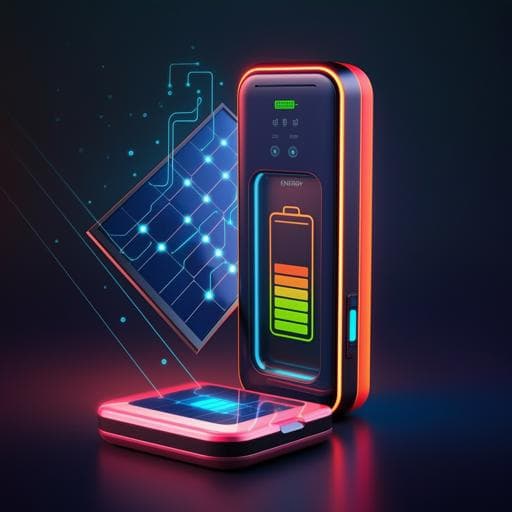
Engineering and Technology
Coupling aqueous zinc batteries and perovskite solar cells for simultaneous energy harvest, conversion and storage
P. Chen, T. Li, et al.
This exciting research presents a groundbreaking device that combines a carbon-based perovskite solar cell with a rechargeable aqueous zinc metal cell, enabling efficient solar energy harvesting, conversion, and storage. Conducted by Peng Chen, Tian-Tian Li, Yuan-Bo Yang, Guo-Ran Li, and Xue-Ping Gao, this integrated solution showcases impressive performance metrics, including high capacity retention and stability over multiple cycles.
~3 min • Beginner • English
Introduction
The work addresses the challenge of building compact, safe, and efficient solar-rechargeable power sources that can both convert and store intermittent solar energy. Traditional four‑electrode solar rechargeable systems (separate solar cell and storage modules) are easy to fabricate but add inactive components, cost, and volume. Two‑electrode bifunctional designs are compact but suffer from low solar utilization and poor stability due to limited spectral response and corrosion. Three‑electrode designs using a multifunctional joint electrode aim to combine advantages but must balance energy, power, efficiency, safety, and cost. The authors define five target metrics (4H1L): high specific energy, high specific power, high overall efficiency, high safety, and low cost, which prior systems have not simultaneously achieved. They hypothesize that integrating a carbon‑based, hole-transport-layer-free perovskite solar cell module with an aqueous Zn metal battery through a protective yet conductive sandwich joint electrode, and employing a heterostructural Co₂P–CoP–NiCoO₂ cathode plus a narrow-range voltage matching strategy, can fulfill 4H1L requirements.
Literature Review
Prior solar rechargeable batteries (SRBs) combining solar cells with Li-ion, Li–S, and other chemistries achieved efficient photocharging and high specific energy but generally had limited power. Incorporating high-power systems like Al-ion raises cost and corrosion issues. Solar rechargeable capacitors (SRCs) offer higher power but insufficient energy and efficiency. Safety and cost are critical for IoT-scale deployment. Materials insights suggest multivalence transition metal oxides (e.g., NiCo₂O₄ or NiCoO₂) for higher energy and intermetallics (CoP, Co₂P) for high conductivity and catalytic activity to boost power. Nanoscale heterostructuring can synergize kinetics and capacity. Aqueous Zn batteries offer low cost and safety (water-based electrolytes, abundant Zn, KOH). Stable, efficient carbon-based perovskite solar cells without HTMs can improve overall SRB efficiency. No prior system simultaneously met the 4H1L metrics; this study targets that gap by integrating an HTM-free carbon perovskite module with an aqueous Zn cell via a multifunctional sandwich joint electrode and voltage matching.
Methodology
Device architecture: An integrated solar rechargeable zinc battery (SRZB) is built by coupling a carbon-based, HTM-free perovskite solar cell (C-PVK) module with an aqueous Zn metal battery through a sandwich joint electrode. The joint electrode has an intrinsic hydrophilic–hydrophobic–hydrophilic structure: the impermeable protective layer is internal, while both outer surfaces are hydrophilic to ensure electrolyte compatibility on the battery side and low-resistance contact on the solar cell side. P‑doped NiCo₂O₄ (P‑NiCo₂O₄) nanoneedle arrays (NAs) are grown in situ on the hydrophilic battery side; the other hydrophilic side serves as the C-PVK counter electrode.
Cathode synthesis (Co₂P–CoP–NiCoO₂ heterostructure): NiCo₂O₄ NAs are grown on carbon paper via hydrothermal synthesis (Ni(NO₃)₂·6H₂O, Co(NO₃)₂·6H₂O, urea in 1:1 H₂O/ethylene glycol; 150 °C, 12 h), followed by annealing (300 °C, 8 h, air). Phosphidation is performed in Ar at 300 °C using NaH₂PO₂·H₂O as the PH₃ source, controlling the NiCo₂O₄:NaH₂PO₂·H₂O (NCO:P) ratio (from 1:0 to 1:8) to tune phase composition. Moderate phosphidation yields an axial heterostructure: a porous rock‑salt NiCoO₂ core with surface-enriched CoP/Co₂P (CoP shell, Co₂P nanocrystallites), and ~3% P doping that increases oxygen vacancies and active sites. Excessive phosphidation or prolonged treatment makes NAs fragile; insufficient phosphidation reduces capacity. Areal mass loading is ~0.3 mg/cm².
Sandwich joint electrode fabrication: One side of Toray carbon paper is protected by drop-cast polystyrene (PS) at 140 °C to create a one-sided barrier. After HNO₃/H₂O (1:4) treatment (90 °C, 30 min), NiCo₂O₄ precursor growth and post-treatments proceed on the unprotected side only; the PS side is cleaned (chlorobenzene), then the structure is annealed and phosphidated as above. Two carbon papers are laminated with an EVA film under 1 MPa for 1 min on a hotplate to form the sandwich electrode.
Perovskite module (HTM-free C-PVK): FTO substrates receive compact TiO₂ (hydrolysis of TiCl₄ at 75 °C) and mesoporous TiO₂ (spin-coated paste), followed by anneals (150 °C 10 min, 500 °C 30 min). The perovskite absorber Cs₀.₁₅FA₀.₈₅PbI₃ is deposited by spin-coating a DMF/DMSO precursor (PbI₂, FAI, CsI, CsCl; diethyl ether antisolvent quench), then annealed at 150 °C for 20 min. A thin carbon buffer layer (doctor-blade) and a thick carbon layer (carbon paste) complete the carbon electrode. Three HTM-free C-PVK cells are connected in series into a module for voltage matching (module V_OC ≈ 2.4 V).
Electrolyte: Aqueous alkaline electrolyte is prepared by dissolving 1.68 g KOH and 91.7 mg Zn(Ac)₂ in 10 mL deionized water (water as solvent).
SRZB assembly: The clear side of the sandwich electrode is bonded to the C-PVK module using carbon paste and annealed (120 °C, 15 min). On the battery side, ~25 µL electrolyte is added to infiltrate P‑NiCo₂O₄; a 1.5 × 1.5 cm cellulose separator is placed and sealed (hot glue). An additional ~75 µL electrolyte saturates the separator. A Zn metal anode (99.9%, 1.2 × 1.2 cm, 0.5 mm thick) is placed on top, encapsulated by hot glue, covered by another glass, and clipped for compactness.
Operation and measurements: Under illumination, perovskite generates e−/h+ pairs; electrons flow via TiO₂/FTO to Zn for Zn²⁺ reduction; holes conduct through the sandwich carbon to oxidize the P‑NiCo₂O₄-based cathode. Photocharge is performed with a solar simulator (68.5 mW cm⁻² to limit heating/evaporation); discharge is galvanostatic (Land tester). Masks define illuminated area (0.21–0.84 cm²) to tune photocharge rate. Photocharge is halted at 1.9 V (below module V_OC), then discharge begins. PV characterization uses 100 mW cm⁻², Keithley 2400, 0.1 cm² mask, and defined scan parameters. Barrier properties (water permeability, resistance) are characterized as controls. Efficiencies are computed as: PCE = J_sc·V_OC·FF/P; overall η = E_discharge/(P·S·t).
Key Findings
- Cathode performance: Co₂P–CoP–NiCoO₂ NAs deliver ~210 mAh g⁻¹ vs ~30 mAh g⁻¹ for undoped NiCo₂O₄, evidencing the benefit of P-doping and heterostructuring. At 32 A g⁻¹, ~170 mAh g⁻¹ is retained (80.9%). Long-term cycling at 32 A g⁻¹ shows 141 mAh g⁻¹ after 25,000 cycles (78.3% retention) with coulombic efficiency >95% (fluctuations due to Zn side reactions); at 2 A g⁻¹, CE >99%.
- Perovskite solar cells: HTM-free single C-PVK achieves PCE = 14.85% (among best for carbon-based HTM-free). The three-cell module exhibits V_OC ≈ 2.4 V but reduced FF due to recombination/resistance.
- Voltage matching and photocharge: ~94.1% of photocharging occurs within 1.75–1.90 V; cutoff is 1.9 V, ensuring strong and steady photocharge current while avoiding overcharge (limited by module V_OC). The device operates effectively within a narrow 1.40–1.90 V battery window.
- Energy and power: After photocharging, the SRZB achieves specific energy 366.4 Wh kg⁻¹ at 2 A g⁻¹; at 32 A g⁻¹, specific power 54.01 kW kg⁻¹ with 293.1 Wh kg⁻¹. Simultaneous illumination during discharge extends discharge time; performance under 0 °C improves versus four-electrode references due to photothermal effects.
- Overall efficiency and stability: Overall η starts at ~5.7% (0.42 cm², discharge 8 A g⁻¹), peaks at 6.4% after ~50 cycles, and remains ~5.9% at 200 cycles. Photocharge/discharge profiles remain nearly unchanged over 200 cycles; discharge capacity ~170 mAh g⁻¹. At cycle 200, the SRZB maintains ~320 Wh kg⁻¹ and ~13.9 kW kg⁻¹.
- Cost and safety: Material costs are markedly lower than SR Li-ion systems: metal (Li vs Zn: ~$3.47 vs $0.18 per g), solvents (dry esters vs water: ~$150 L⁻¹ ≈ $0.15 mL⁻¹ vs ~$0.0003 mL⁻¹), salts (LiTFSI vs KOH: ~$10.7 vs $0.04 per g). Aqueous electrolyte exhibits non-flammability (separator with organic electrolyte ignites; aqueous-saturated remains intact). The photocharge voltage is limited by the solar module V_OC, reducing overcharge risk.
Discussion
The integrated SRZB directly tackles the 4H1L targets. High specific energy is enabled by a high-capacity NiCoO₂ core undergoing multi-electron reactions; high specific power is supported by conductive, catalytically active CoP/Co₂P at the surface and nanoscale architecture promoting rapid kinetics. The sandwich joint electrode ensures water isolation for perovskites while maintaining low-resistance contacts, enabling a compact three-electrode design. Narrow-range voltage matching (module maximum power point close to the Zn cell plateau, photocharge confined largely to 1.75–1.90 V) maximizes the energy transfer efficiency. Aqueous Zn chemistry with KOH and water ensures inherent safety and low cost. The device demonstrates stable operation over 200 photocharge/discharge cycles with minimal performance decay, while the zinc cell alone endures >25,000 cycles, indicating potential for long life. The results validate that coupling HTM-free carbon perovskite modules with an advanced aqueous Zn battery through a multifunctional joint electrode can simultaneously deliver high energy, power, efficiency, safety, and cost advantages over conventional solar rechargeable architectures.
Conclusion
This study presents a monolithic solar rechargeable zinc battery integrating an HTM-free carbon perovskite module with an aqueous Zn metal cell via a multifunctional sandwich joint electrode featuring a Co₂P–CoP–NiCoO₂ heterostructured cathode. The device achieves specific energy up to 366 Wh kg⁻¹ (2 A g⁻¹), specific power up to 54.01 kW kg⁻¹ (32 A g⁻¹), peak overall efficiency of 6.4% with stability around ~5.9% after 200 cycles, and strong safety/cost benefits from aqueous electrolytes and abundant materials. Future work could target: improving module fill factor and stability (e.g., optimized carbon electrodes or robust HTM alternatives), mitigating recombination and series resistance, scaling illuminated area without efficiency loss, automating photocharge control, and further suppressing Zn side reactions via electrolyte engineering and anode surface modification to enhance CE and long-term device stability.
Limitations
- The HTM-free perovskite module shows reduced fill factor and efficiency versus state-of-the-art perovskites, limiting overall η; module stability is lower than single-cell devices and degrades slightly under prolonged light/heat/moisture exposure.
- Integrated device cycling was demonstrated for 200 photocharge/discharge cycles; longer-term stability of the full SRZB (beyond 200 cycles) under varied environmental conditions remains to be validated, although the Zn cell alone exceeds 25,000 cycles.
- Coulombic efficiency fluctuates (>95%) at high current due to side reactions and inhomogeneous Zn deposition; further electrolyte/anode engineering is needed for improved CE.
- Performance drops when increasing the active photocharge area due to PCE loss and mismatch; scale-up requires addressing recombination and resistive losses in the module.
- Photocharge/discharge control was manual in experiments; practical systems will require robust power management and encapsulation to handle environmental stress and prevent electrolyte loss.
Related Publications
Explore these studies to deepen your understanding of the subject.







